Brewing Beer with Special B Malt
Published: August 10, 2025 at 11:14:57 AM UTC
Last updated: December 12, 2025 at 3:04:17 PM UTC
Using Special B malt in brewing beer is a method to craft complex, richly flavored brews. This malt is celebrated for its sweet, raisiny, or pruney taste. It's a favorite among brewers for its unique flavor profile. The inclusion of Special B malt in brewing beer profoundly influences the taste and character of the final product. It's frequently employed in darker Belgian ales and specialty beers to enhance depth and complexity. By mastering the use of this malt in the beer making process, brewers can produce distinctive, delectable beers that captivate audiences.
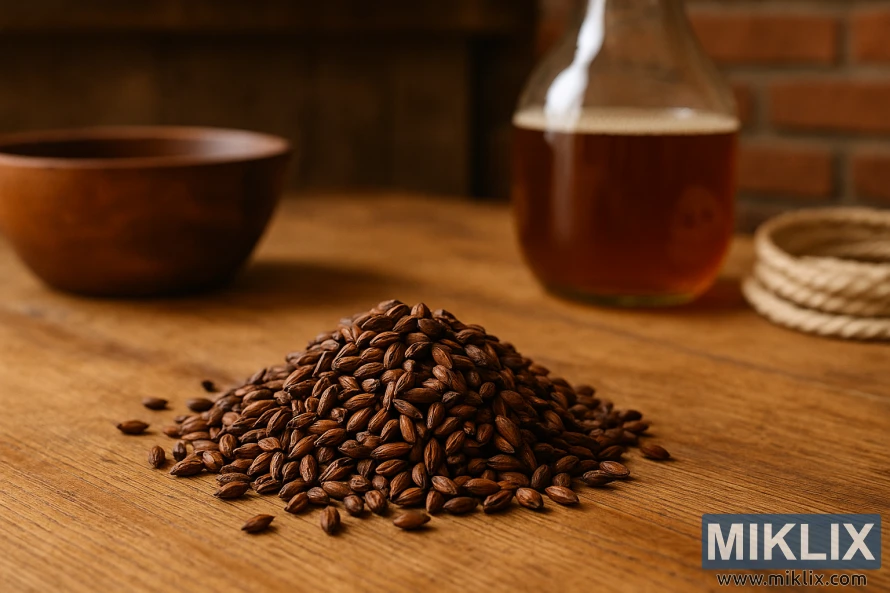
Key Takeaways
- Special B malt adds a sweet and raisiny flavor to beers.
- It is commonly used in brewing darker Belgian ales.
- The malt can add complexity and depth to various beer styles.
- Effective use of Special B malt requires understanding its impact on the brewing process.
- It is a popular choice among brewers for creating unique beers.
Understanding Special B Malt
Special B malt, a type of malted barley, is highly valued for its unique characteristics and brewing capabilities. It undergoes a specific malting process. This includes germination, drying, and roasting, resulting in a rich, complex flavor profile.
The malting process for Special B malt is key in developing its distinctive flavor and dark color. The roasting stage is critical. It contributes to the malt's deep, caramel-like flavors and aromas. This makes it a valuable ingredient in various beer styles.
Breweries often choose Special B malt for its ability to add depth and complexity to their beers. The malt flavor it imparts is a key component in creating balanced and nuanced brews.
Understanding the characteristics of Special B malt is essential for brewers looking to incorporate it into their recipes effectively. By leveraging its unique properties, brewers can create a wide range of beer styles with distinct flavor profiles.
The Distinctive Flavor Profile of Special B Malt
Special B malt is celebrated for its unique flavor profile, essential in brewing darker Belgian ales and specialty beers. It offers sweet and raisiny or pruney notes, enriching beers with a complex character.
Brewers often choose Special B malt for its distinctive taste. It adds depth and complexity to beers, elevating their overall character.
Key flavor characteristics of Special B malt include:
- Rich, sweet flavors
- Raisiny or pruney notes
- Complex character
These flavors are perfect for darker Belgian ales and specialty beers. They allow brewers to craft beers with a unique and captivating taste.
Color Contribution in Beer Making
Special B malt's roasting process imbues beer with a distinctive dark color and complex flavor. This malt is essential for brewers aiming to craft beers with deep, rich hues. The roasting process heats the malted barley to high temperatures, bringing out its natural colors and flavors.
Special B malt enables brewers to create a variety of dark beer styles, from dark ales to stouts and porters. By adjusting the Special B malt proportion in a recipe, brewers can achieve the desired darkness and complexity. This versatility makes Special B malt a valuable component in many brewing recipes.
Special B malt also impacts the flavor and body of beer. Its roasted flavor adds depth and complexity, making it a favorite among brewers. Used correctly, Special B malt can transform a good beer into an exceptional one, providing a rich, satisfying taste experience.
Brewing techniques, including the mashing process and the Special B malt proportion, are critical in achieving the desired color and flavor. By mastering these techniques, brewers can fully exploit Special B malt's unique qualities, creating unique and captivating beers.
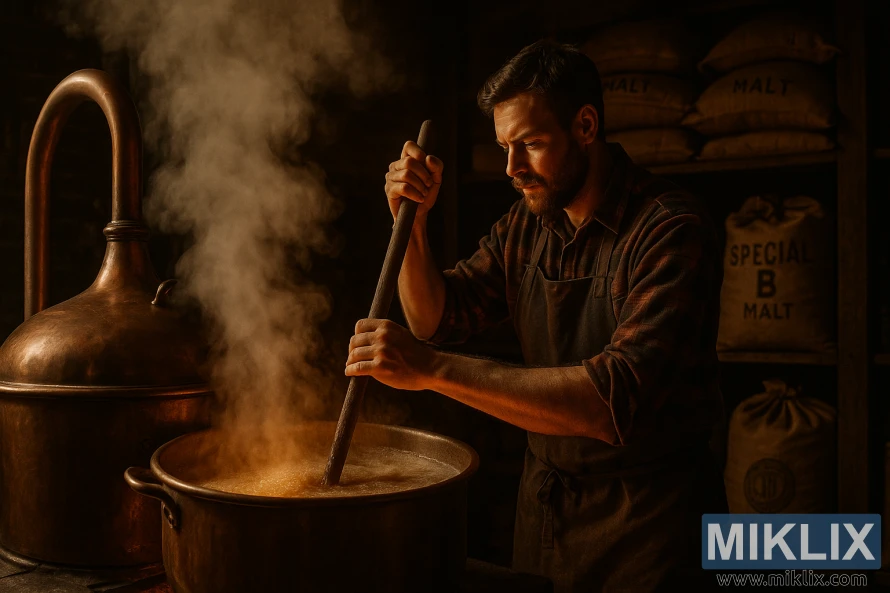
Common Beer Styles Using Special B Malt
Special B malt is a staple in many traditional beer styles. It's prized for its ability to craft complex, dark ales that burst with flavor and character.
Its popularity soars in brewing darker Belgian ales, like dubbel and quadrupel. These ales are celebrated for their deep, reddish-brown hues and rich, layered flavors. Special B malt significantly boosts these qualities.
Special B malt also shines in porters and stouts. These styles gain from its capacity to introduce depth and complexity to the brew.
- Dubbel: A dark, reddish-brown ale with a complex flavor profile.
- Quadrupel: A strong, dark ale with a rich, complex character.
- Porters: Dark beers with a robust flavor profile.
- Stouts: Dark, roasted beers with a dry finish.
By integrating Special B malt into their recipes, brewers can craft a diverse array of beer styles. These beers are not only unique but also incredibly enjoyable.
Optimal Usage Rates in Different Beer Recipes
The amount of Special B malt in beer recipes greatly affects the final product's character and complexity. Brewers typically use Special B malt in small amounts, around 5-10% of the total grain bill. This is to add depth without overwhelming other ingredients.
Using too much Special B malt can lead to an overly sweet or unbalanced flavor. On the other hand, using too little might not fully achieve the desired characteristics. The ideal amount can vary depending on the beer style being brewed.
In darker beer styles like Belgian Quadrupels or Dubbels, a higher percentage of Special B malt is often used. This enhances the beer's rich, complex flavors. For styles like Brown Ales or Porters, a moderate amount is usually enough to add a subtle depth.
- For strong, dark ales, consider using 8-12% Special B malt.
- For brown ales or mild porters, start with 3-5% and adjust to taste.
- Experiment with different ratios to find the optimal balance for your specific recipe.
Brewing is both an art and a science, and Special B malt usage is no different. By understanding and adjusting the usage rates, brewers can create beers that are complex yet balanced.
Special B Malt Storage and Handling
Preserving the unique flavor of Special B malt requires careful storage and handling. The right storage conditions are key to maintaining the quality of brewing ingredients. This includes Special B malt.
For optimal preservation, store Special B malt in a cool, dry place. It should be away from direct sunlight and moisture. This approach helps keep the malt's distinctive flavor and ensures it works well in brewing.
Here are some key considerations for storing and handling Special B malt:
- Store in airtight containers to protect against moisture and contaminants.
- Keep the storage area at a consistent, cool temperature.
- Avoid exposure to direct sunlight, which can degrade the malt.
- Handle the malt gently to prevent damage to the grains.
By adhering to these guidelines, brewers can keep their Special B malt in top condition. This is essential for crafting high-quality beers. Proper storage and handling are critical for consistent brewing results and maintaining the integrity of brewing ingredients.
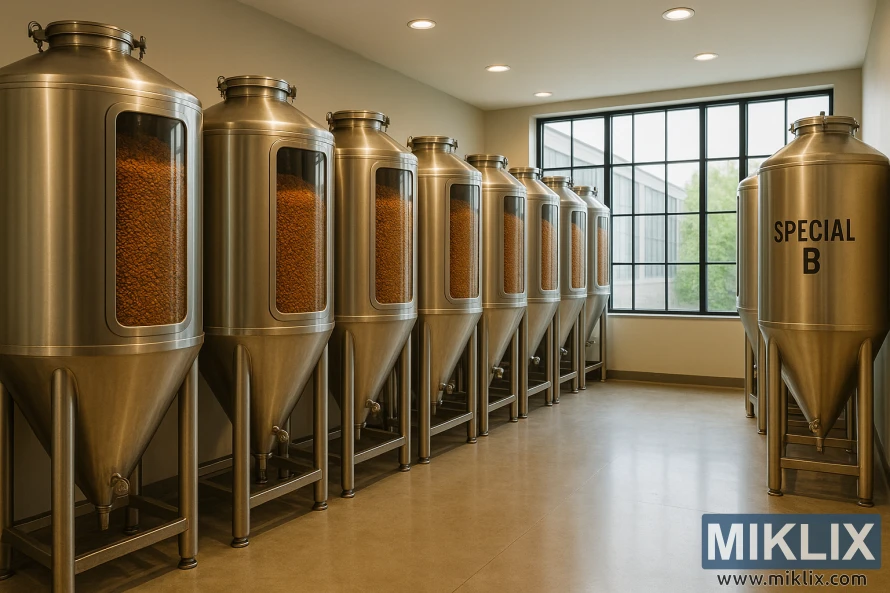
Mashing Techniques for Special B Malt
Special B malt requires a careful mashing approach to reveal its full flavor. The mashing process is key in brewing with this malt. It directly influences sugar extraction and the beer's flavor.
When mashing with Special B malt, several factors are important. The malt's high kilning temperature affects its enzymatic activity. Combining it with a base malt of higher diastatic power is often beneficial for saccharification.
The mashing temperature is also critical. A range of 152°F to 155°F (66°C to 68°C) is recommended for a rich, complex wort. The exact temperature may vary based on the beer style and desired fermentability.
- Use a step mash or a single infusion mash at a higher temperature to emphasize body and complexity.
- Consider the pH of the mash, as it affects enzyme activity; a pH between 5.2 and 5.4 is generally considered optimal.
- Monitor the mash for signs of adequate conversion, such as a negative iodine test.
Brewing beer with Special B malt demands patience and attention to detail during mashing. Optimizing the mashing technique allows brewers to fully exploit this specialty malt. This results in a beer that is rich, complex, and full of character.
Combining Special B with Base Malts
The choice and amount of base malts alongside Special B malt greatly affect the beer's taste. Base malts form the beer's flavor and fermentability base. Special B malt, on the other hand, brings complexity and depth.
When blending Special B with base malts, the type and quality of the base malts matter. Common base malts paired with Special B include:
- Pale malt for its light color and neutral flavor
- Pilsner malt for its crisp, clean taste
- Munich malt for its rich, malty flavor
The ratio of Special B malt to base malts varies by desired beer style and taste. A common starting point is 5-15% Special B malt in the total grist. This can be tweaked based on the brewer's taste and the recipe.
For a balanced taste, understanding both Special B malt and base malts' characteristics is key. For instance, using a robust base malt like Munich might require less Special B malt to prevent overpowering the beer.
Some effective strategies for mixing Special B with base malts include:
- Trying different base malt mixes to find the perfect blend
- Keeping an eye on the beer's taste during brewing and adjusting the malt mix as needed
- Thinking about how the base malts influence the beer's overall character and adjusting the Special B malt amount
Alternative Malts and Substitutions
Brewers often seek out alternative malts to replicate the unique flavors of Special B malt. This section delves into some of these substitutes and their uses in brewing.
Special B malt is celebrated for its complex flavors, including dark fruit and chocolate notes. Brewers looking for substitutes can explore other specialty malts with similar profiles.
- Dark Munich malt, which adds a deep malty flavor and aroma.
- Chocolate malt, known for its cocoa-like flavors.
- Carafa malt, which contributes a roasted flavor without excessive bitterness.
Choosing the right substitute for Special B malt requires understanding the desired flavor profile. Each alternative malt has its own distinct characteristics. The substitution ratio can vary significantly.
For instance, to replicate dark fruit flavors, brewers might blend malts. A mix of dark Munich and a hint of chocolate malt can mimic Special B's complex taste.
By grasping the essence of Special B malt and its alternatives, brewers can make informed substitutions. This knowledge enhances brewing flexibility and creativity.
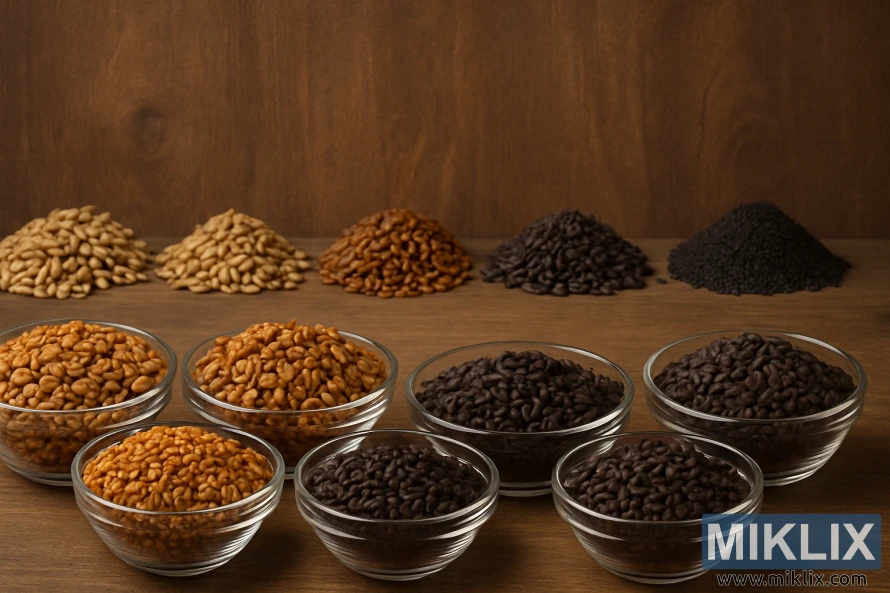
Troubleshooting Common Issues
Troubleshooting is a critical skill for brewers using Special B malt. It helps overcome common problems like flavor imbalances and color inconsistencies. These issues can greatly affect the final product's quality.
Some common problems brewers face with Special B malt include:
- Overly dark or inconsistent color
- Unbalanced flavor profiles
- Difficulty achieving desired ABV or body
To tackle these issues, brewers can tweak their recipes and techniques. For instance, adjusting the mash temperature or the amount of Special B malt used can balance flavors. Proper storage and handling of Special B malt can also prevent staling or contamination.
Understanding Special B malt's characteristics and being mindful of common pitfalls allows brewers to proactively address these issues. This way, they can ensure the production of high-quality beers.
Advanced Brewing Tips with Special B
Special B malt is a versatile ingredient for advanced brewing techniques. It allows brewers to experiment with mashing schedules, hop combinations, and yeast strains. This experimentation leads to unique and complex flavor profiles.
Adjusting the mashing schedule can highlight Special B malt's characteristics. A higher mash temperature can result in sweeter, more complex flavors. On the other hand, a lower temperature can produce drier, more nuanced tastes.
Pairing Special B malt with complementary hop varieties is another approach. For example, earthy, herbal hops can enhance the malt's rich, toasty flavors. Popular hop varieties for pairing include:
- East Kent Goldings
- Willamette
- Hallertau
Yeast selection is also critical when brewing with Special B malt. Yeast strains with high attenuation rates can balance the malt's rich flavors. Recommended yeast strains include:
- Saccharomyces cerevisiae (e.g., Wyeast 1007 or Safale US-05)
- Saccharomyces pastorianus (e.g., Wyeast 1272 or Fermentis Safale S-04)
By experimenting with these advanced techniques, brewers can unlock Special B malt's full flavor. This leads to complex, nuanced beers that showcase its unique characteristics.
Impact on Body and Mouthfeel
Special B malt adds a richer, fuller-bodied quality to beer, making it smoother to drink. It's known for improving the texture and drinking experience across various beer styles.
Special B malt's inclusion in a recipe can change a beer's body and mouthfeel in several ways:
- Increases the beer's viscosity, contributing to a fuller body.
- Enhances the mouthfeel by adding a smooth, creamy texture.
- Can influence the beer's overall complexity and depth.
The exact impact of Special B malt on body and mouthfeel varies. It depends on brewing techniques, the amount used, and the beer style.
Brewing methods, like mashing temperatures and sparging, are key. For example, a higher mashing temperature can make the beer fuller. A lower temperature might balance the flavor better.
To get the right body and mouthfeel, brewers should:
- Try different amounts of Special B malt to find the best balance for your beer.
- Adjust brewing techniques to match Special B malt's characteristics.
- Watch the fermentation and conditioning to ensure the desired body and mouthfeel.
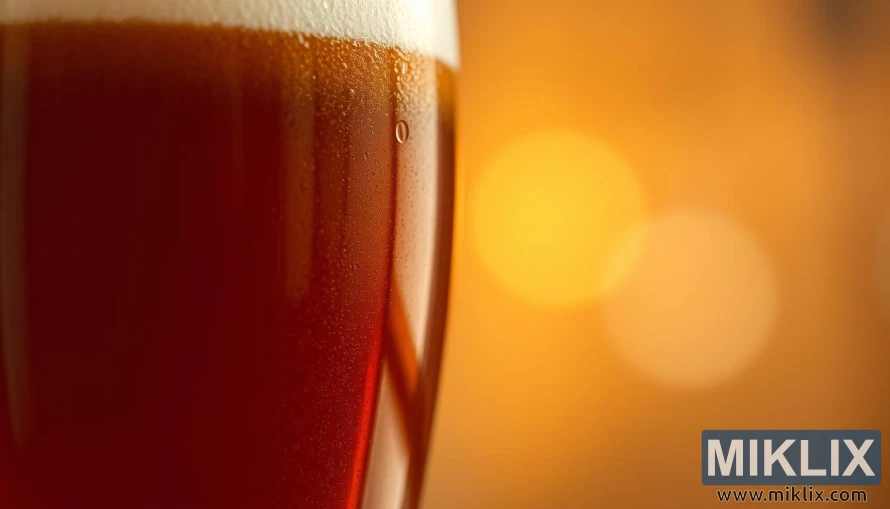
Aging and Conditioning Considerations
The aging and conditioning process is key in shaping the final flavor of beers made with Special B malt. Brewers must think about how these phases will affect the beer's quality.
Aging allows flavors to mature and blend, which is critical with Special B malt's strong taste. The aging time varies by beer style and recipe. Beers with high alcohol or more Special B malt might need longer aging to balance out.
Conditioning involves storing the beer at cooler temperatures to clarify and mature further. This step greatly impacts clarity, flavor stability, and drinkability. For beers with Special B malt, careful conditioning is essential to avoid off-flavors or imbalance.
Several factors influence aging and conditioning, including storage temperature, packaging type, and desired flavor. Brewers should consider these when planning their aging and conditioning regimen.
- Storage temperature: Cool, consistent temperatures are ideal for aging and conditioning.
- Packaging: The type of packaging (e.g., bottles, cans, kegs) can affect the beer's exposure to oxygen and light, impacting the aging process.
- Desired flavor profile: Brewers should have a clear idea of the flavor profile they aim to achieve through aging and conditioning.
By managing aging and conditioning carefully, brewers can bring out the best in Special B malt. This results in high-quality beers with complex, balanced flavors.
Commercial Examples Using Special B Malt
Special B malt has been a game-changer in commercial brewing, leading to the creation of exceptional beers. Breweries globally use this malt in various styles, highlighting its versatility and unique flavor contributions. This versatility makes it a favorite among brewers.
In Belgian ales, Special B malt shines, adding a rich, complex flavor profile. Breweries making Belgian Quadrupels and Flemish Red ales depend on it for depth and character. It also enhances the color and flavor of porters and stouts, adding a robust, malty taste.
- Flanders Red ales, known for their balanced blend of sweet and sour flavors
- Belgian Quadrupels, characterized by their rich, complex malt profiles
- Porters and stouts, which benefit from the malt's color and flavor contributions
These examples show Special B malt's impact on brewing. By studying these beers, brewers can learn how to use Special B malt effectively in their recipes.
Recipe Development Guidelines
Developing recipes with Special B malt requires brewers to grasp its unique flavor and color contributions. This malt is renowned for its deep, rich taste and significant impact on beer color. It's a key ingredient in specific beer styles.
To effectively use Special B malt, brewers must first understand its flavor and color impact. Its distinct taste, featuring dark fruit, chocolate, and sometimes a roast hint, needs to be balanced with other ingredients. This balance is critical for achieving the desired beer profile.
Here are some key considerations for brewing recipes that incorporate Special B malt:
- Determine the desired flavor profile and color of the final beer.
- Balance the robust flavors of Special B malt with complementary ingredients.
- Consider the brewing technique and style to ensure compatibility with Special B malt.
- Adjust the amount of Special B malt according to the recipe's specific requirements.
Brewing recipes with Special B malt can span from dark ales to complex stouts. The success of these recipes hinges on understanding how Special B malt interacts with other ingredients. Adjustments must be made to the recipe to achieve the best results.
By carefully considering Special B malt's unique characteristics and applying sound brewing practices, brewers can craft a wide array of exceptional beers. These beers will highlight the malt's distinctive qualities.

Conclusion
Mastering Special B malt in your brewery demands a deep grasp of its unique flavor and characteristics. By integrating Special B malt into your brewing, you can craft complex, balanced, and delectable beers. These beers will highlight its distinctive character.
Effective use of Special B malt is fundamental to brewing mastery. It allows brewers to create high-quality beers that satisfy even the most discerning beer lovers. To achieve this mastery, brewers must experiment with various brewing techniques and recipes. They need to understand how Special B malt interacts with other ingredients in the brewing process.
By adhering to the guidelines in this article, brewers can fully exploit Special B malt's capabilities. Whether you're an experienced brewer or just beginning, mastering Special B malt is vital. It's a key step in brewing exceptional beers that excel in the craft brewing world.
Further Reading
If you enjoyed this post, you may also like these suggestions:
